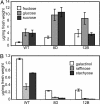Phloem loading in Verbascum phoeniceum L. depends on the synthesis of raffinose-family oligosaccharides
- PMID: 18048337
- PMCID: PMC2148338
- DOI: 10.1073/pnas.0707368104
Phloem loading in Verbascum phoeniceum L. depends on the synthesis of raffinose-family oligosaccharides
Abstract
Phloem loading is the initial step in photoassimilate export and the one that creates the driving force for mass flow. It has been proposed that loading occurs symplastically in species that translocate carbohydrate primarily as raffinose family oligosaccharides (RFOs). In these plants, dense fields of plasmodesmata connect bundle sheath cells to specialized companion cells (intermediary cells) in the minor veins. According to the polymer trap model, advanced as a mechanism of symplastic loading, sucrose from the mesophyll diffuses into intermediary cells and is converted there to RFOs. This process keeps the sucrose concentration low and, because of the larger size of the RFOs, prevents back diffusion. To test this model, the RFO pathway was down-regulated in Verbascum phoeniceum L. by suppressing the synthesis of galactinol synthase (GAS), which catalyzes the first committed step in RFO production. Two GAS genes (VpGAS1 and VpGAS2) were cloned and shown to be expressed in intermediary cells. Simultaneous RNAi suppression of both genes resulted in pronounced inhibition of RFO synthesis. Phloem transport was negatively affected, as evidenced by the accumulation of carbohydrate in the lamina and the reduced capacity of leaves to export sugars during a prolonged dark period. In plants with severe down-regulation, additional symptoms of reduced export were obvious, including impaired growth, leaf chlorosis, and necrosis and curling of leaf margins.
Conflict of interest statement
The authors declare no conflict of interest.
Figures






References
-
- Lalonde S, Tegeder M, Throne-Holst M, Frommer WB, Patrick JW. Plant Cell Environ. 2003;26:37–56.
-
- Schulz A. In: Plasmodesmata. Oparka KJ, editor. Oxford: Blackwell; 2005. pp. 135–161.
-
- Turgeon R, Ayre BG. In: Vascular Transport in Plants. Holbrook NM, Zwieniecki MA, editors. Oxford: Elsevier/Academic; 2005. pp. 45–67.
MeSH terms
Substances
Associated data
- Actions
- Actions
LinkOut - more resources
Full Text Sources
Other Literature Sources

